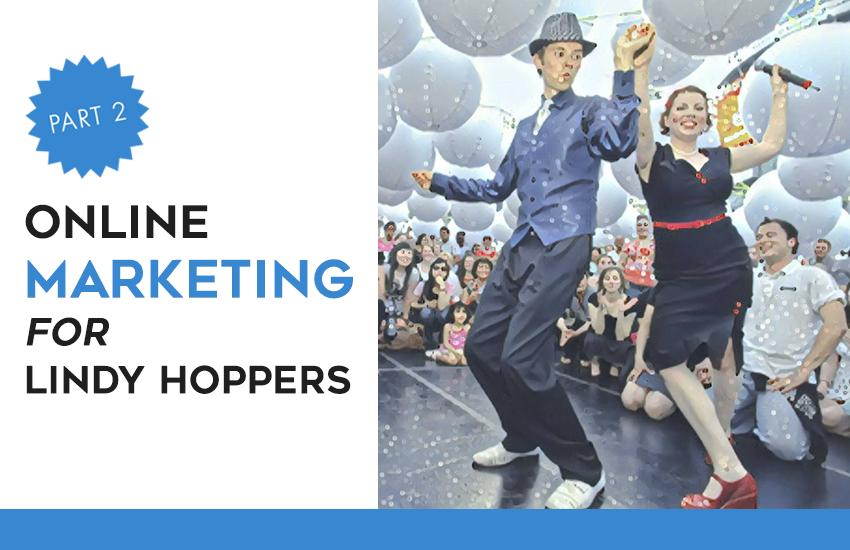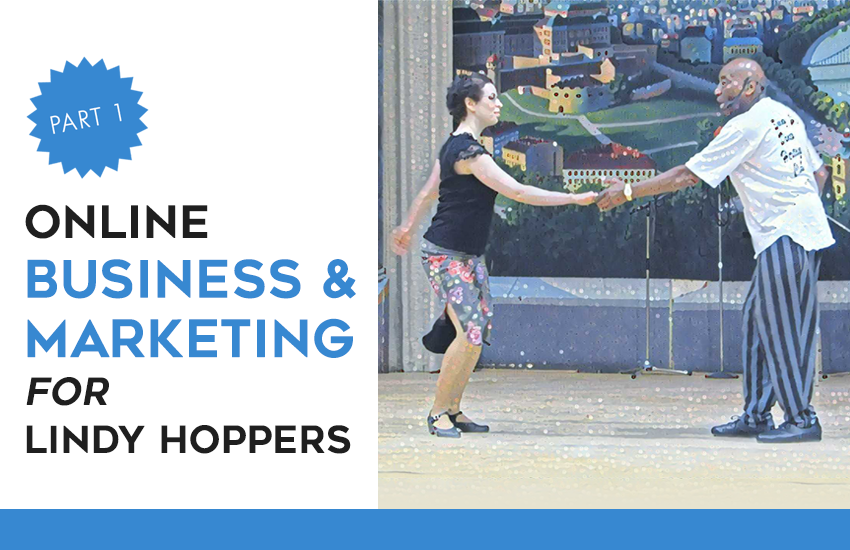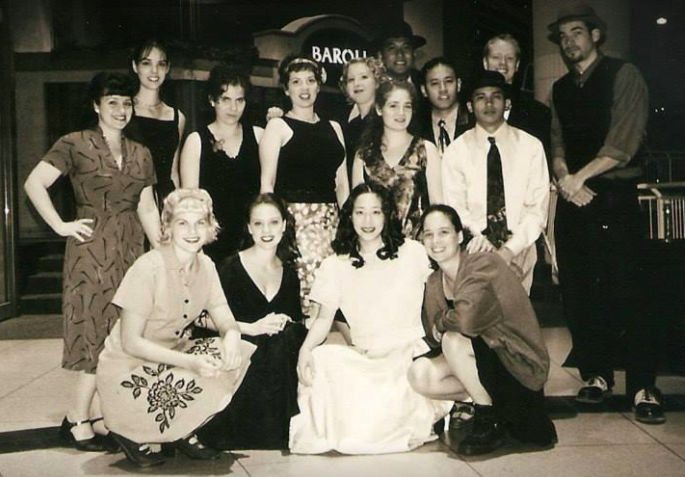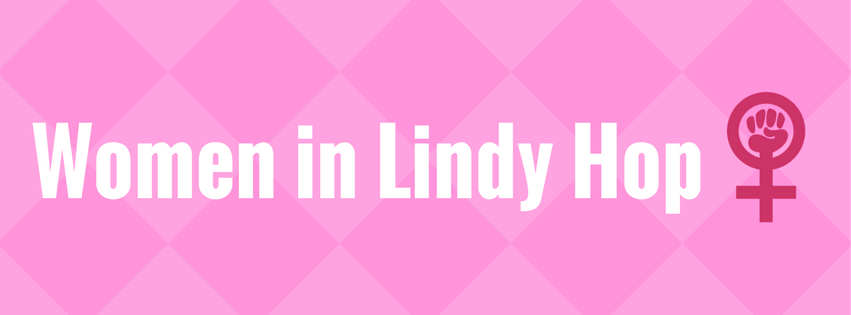This is a continuation of the blog post I started here. In Part 1, I talked about your offering, aka. your value proposition, and monetization considerations. Now I’ll get into what will make or break your success: marketing.
Marketing is Everything
I believe that marketing is the most important part of your online business. It doesn’t matter how great of an offer you have or how talented you are; if you can’t get in front of enough of the right people, you will struggle.
Understand Your Audience
Who should you really be catering your offering towards? In an online capacity, you have three main possible target groups:
- People who already Lindy Hop and already know you
- A targeted niche, your biggest fans, but a limited pool
- People who already Lindy Hop in general but may not know you or be connected with you (yet)
- Also a targeted niche but with a much wider net
- People who don’t Lindy Hop yet—they could be complete beginners or people from other dances
- A much wider net but much more unknown with a very different sales cycle
Right now, I see most Lindy Hop instructors focusing far too much on Group 1, the people who they’re already connected with. That’s definitely a warm audience and they’re probably your biggest cheerleaders, but it’s too limited of a pool to rely on for all of your income.
This is the same problem that local dance schools face when they rely too much on their existing intermediate and advanced students for their income. It might work well for a little while, but it’s not enough to sustain your business. You need to be continuously bringing in new people. You’ll have periods of thriving attendance but at some point, your existing student base will start to burn out, run out of money, get too busy, get tired of your offering, or just turn over.
When this pandemic is eventually over and we go back to some kind of normal, local schools need to get back to building their schools up from the bottom up; by bringing in new beginner dancers. They can rely on local targeting alongside benefits like joining a friendly social community to fill their classrooms.
Find your Niche Within the Lindy Hop Niche
In an online capacity, you might decide to offer beginner classes, but it’s a harder, much more unknown market to try to reach. As such, your marketing has to be a lot more creative and convincing to win over “civilians” or “muggles” who are completely unfamiliar with LindyHop. This is even harder when people won’t be benefiting from the social aspects of the dance.
Instead, you need to really take advantage of the wider global Lindy Hop community.
Just as a beginner audience may be potentially vast, an offer that’s too advanced or specialized has the smallest potential reach. Also keep in mind the restrictiveness of only offering partner classes when many people do not have access to a partner or social community; more solo offerings will likely be advantageous.
According to my search on May 10th in Facebook’s business ads manager, a worldwide audience of people of any gender, ages 18 to 65+ who already show “Lindy Hop” as an interest has the potential to reach 790K people.
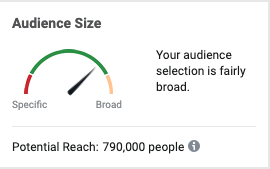
That is a much better potential audience to try to reach to build a sustainable business than the few hundred or thousand in your current network.
Understand Your Current Marketing Reach
Remember when the Lindy Hop community relied on message boards? It was actually a much simpler marketing world back then and it was far easier to disseminate news and advertising to the Lindy Hop community than it is now.
We now live in a technologically “connected” but completely dispersed online dance community. Facebook is by far the biggest platform for Lindy Hop but content is decentralized. You only see some of the content from the people and pages in your existing network. I promise you that there are many Lindy Hop circles and groups that you don’t even know about–and you don’t realize how many potential customers you aren’t reaching. Our community is becoming more decentralized all of time because we’re relying on Facebook’s extremely finicky algorithms.
Facebook filters posts at all levels so only a select number of your connections will see your content. The more people who do engage with a piece of content, especially in the form of comments, the more Facebook will show that post. So the more popular your post is, the more popular it will continue to become. Meanwhile, most of your posts aren’t getting in front of enough people in the first place thanks to the filters so it’s very hard to gain the engagement that will help foster more visibility. It’s a conundrum.
Here’s how Facebook really works at all levels:
Facebook Personal Page
You can be connected with up to 5000 friends. The algorithms are less tight than with business pages, but most of those “friends” still won’t see your posts.
Facebook Business Page
There are no limits to how many people can like your page. You need a business page in order to run advertising so having a business page is a must. However, your organic posts will be heavily filtered by the algorithms though you have the option to pay (boost or fully advertise) your posts to reach more people. You should also connect your business page with your Instagram account so you can advertise in both locations. (Make sure your Instagram account has been converted to a business account in the settings.)
Facebook Groups
Groups are designed for community engagement and you’ll have more success with the algorithms in a group than you will on a page. A successful group with a lot of community engagement can be one of the best ways to build community loyalty and to softly push your offers at no cost. You can connect an existing group with your business page or start to build a new group if you don’t already have one. There are still some limitations with groups; group posts can’t be shared outside of the group, and your posts still won’t reach all of your group members, the algorithms are a bit better in groups than on pages. Also, people who aren’t already in your group might have a hard time finding out that your group even exists.
Facebook Events
Your events should always be connected with a Business Page, or sometimes under very limited circumstances with a Group, but only if you’re holding private, limited events. Once people have joined your event, their friends and connections will often see notices in their newsfeed saying “Frankie and Norma are attending X Event” making it a great tool to get the word out about your date-based offerings. The good news is it’s very inexpensive to run advertisements to promote Facebook events. The algorithm for sharing your posts on the event page wall isn’t bad, but still not all of your attendees will see your posts. Still, events are a quite good and cost effective way to get the news out about events. The biggest downside to events is that once the event is over, the Facebook event becomes disabled and you lose the audience you built.
By the way, another algorithm hit that you should be aware of is that Facebook has started to penalize links that take people away from Facebook vs. content that keeps people on Facebook. So if you’re sharing a video from YouTube, it won’t get nearly the reach that the same video would get if you upload it directly to Facebook. The same goes for all external links. That’s another favourable reason to leverage Facebook events in your promotions whenever possible, or to upload your graphic and content directly to Facebook; you won’t be penalized in the algorithms for sending people away from Facebook.
Other Platforms
Instagram has grown far more slowly in our Lindy Hop community than in most circles. Maybe because Lindy Hop has been so extremely active on Facebook. But in my opinion, having some sort of Instagram presence will continue to be important in our community. Instagram also experiences algorithm challenges. Posting at a certain time of day is pretty meaningless because your post will be shown to your followers based on Instagram’s own unique algorithms.
On Instagram, you have two ways to reach people. There’s your regular posts (feed) and then there are stories.
a. Instagram Feed
You can create something purely visual and beautiful in your Instagram feed that populates your wall and that can capture something visual about you and your personal/professional brand in a way that Facebook can’t. (On the other hand, Facebook is far better for discussion. So you need both.)
You shouldn’t just share the exact same content on both Instagram and Facebook; in fact, I strongly discourage you from always posting the exact same content to both platforms. Occasionally it’s ok, but not for every post. These platforms are different and need to be handled with a different approach. Otherwise, it could feel like you’re spamming people.
Instagram offers a unique opportunity for you to diversify the way you’re reaching people and to tell a different kind of story.
b. Instagram Stories
Speaking of stories, Instagram stories offer a very unique way for you to let your guard down, show who you really are and what your daily life is like, in a way that today’s social media users are craving. Stories disappear after 24 hours, so you don’t want to put in too much effort into making them perfect. They’re great for getting more personal, candid, silly, or even off topic in a way that will help people get to know you. You might only post photos or videos to your newsfeed a few times a week when it’s something really good and strategic, but you can post to your stories as often as you’d like, even multiple times a day if you get on a roll.
*Please, avoid sharing too many photos to your Instagram newsfeed in a single day unless you have a darned good reason for it. It’s a good way to get unfollowed. Because you can only see one photo or video at a time as you scroll through Instagram, you want to be conscious about not flooding and “hogging” people’s Instagram feeds. Be selective about what goes in your feed and share the rest to stories instead.
TikTok, Twitter, LinkedIn, Pinterest, etc.
Please see my note in Part 1 about TikTok as a potentially untapped opportunity for Lindy Hop. There are other platforms too but they’re mostly a waste of time for your marketing efforts. If you’re very focused on blogging or photography, Pinterest could work for you, but I’m not going to go down those roads.
Google My Business, Google Ads & SEO
Google is exceptionally important for local schools. Anyone keeping their local operations on life support during the pandemic might want to take this opportunity to update their Google My Business account. Google Ads can also be a worthwhile tool for essential seasonal registration like the month of September and throughout the holidays leading into January, but they can get expensive—far more expensive than Facebook & Instagram ads.
SEO is also extremely helpful for local schools. I recommend that every local school has a blog post on their website entitled something like, “So you’re looking for the best swing dance classes in XCityX?” and then goes on to explain all of the benefits of learning Lindy Hop and joining the local community. This blog post should have as many keyword strings that include your city as possible. It’s one of the easiest free ways to get picked up by Google. But there’s a lot more you can do with your local SEO.
SEO is a much longer marketing play and a bigger subject that I won’t get into too much here but I’ll say this. While SEO is important, it’s not something you’ll see a return on soon. As such, I’m not recommending it as a focus for online Lindy Hop businesses right now. You’ll get far more return on your time, energy, and financial investment on paid digital advertising on Facebook and Instagram.
On the other hand, it’s always good to build up your website, which acts as your storefront for your offerings. So having content on your website that people are actively searching for can be optimized to help your overall website traffic and potentially your sales. Here are several blog posts I’ve written about SEO if you’d like to learn more.
Strategic Cross-Posting
The biggest mistake I see from Lindy Hoppers in their current marketing is relying too much on posting either in too few of the above locations OR cross-posting too repetitively. There’s a balance you need to strike, and if you can find the sweet spot, you can make the most of the free opportunities available to us.
What I don’t think works very well at all (though I’ve been known to do it myself for the Frankie Manning Foundation because it’s quick and easy) is just posting the exact same thing in all of the Lindy Hop groups you’re part of and then calling it a day. This isn’t a bad place to get started, but those groups tend to have a lot of the same people in them and it can be a bit of a bombardment to too few people.
What works better is to adjust your messaging and approach to cross- posting. Try to mix things up in both your visual elements, written messaging, and also the timing of your posts so it isn’t repetitive. That way you’ll still be maximizing your free/organic reach as much as possible but it won’t feel so repetitive.
Your Network Needs Reminders
Don’t spam your friends with your promotions on your personal page every day BUT remind your friends reasonably regularly that you’re offering something and that they can learn more about it by joining your group and liking your page. This is a biggie. Slip it into regular conversation so that you aren’t just selling all the time. Mention how you’re excited to be working on something. And definitely mention and even use the @tag to link to your page and group at least once a month, maybe even more often during the pandemic.
I recently noticed that some teachers who I admire had not mentioned their online classes at all on their personal pages. I hadn’t received any notifications from their page so I didn’t know about their offering. Actually, I had already followed their business page a long time ago but I forgot it existed because the algorithm never showed me any of their content. If it hadn’t been for Instagram, I wouldn’t have known about their lessons. So hop onto your personal page once in a while to mention that your other locations (business page, group, Instagram) exist because your friends and followers might not know about them or may have forgotten.
Soft vs. Hard Selling
Your business page is the best place for straight up promotions, but even then you don’t want to only use it for 100% advertising. Check out what I have to say about content marketing further down in this article. Your Facebook event page is also a good place for more direct promotions, ut you can also benefit from mixing in other enticing content.
Your Facebook group should generally be used for a softer sell. The focus should mostly be on conversation, engagement, and a free content (content marketing) to foster a community feeling.
Post to all of your Facebook locations regularly, alongside Instagram, but try to find fresh ways to get your message out into the community. This does take time and energy, but it’s the best free and inexpensive way to reach people, and it can be worth the energy.
Organic Marketing vs. Paid Advertising
I really feel that most Lindy Hoppers are overestimating the reach they think they’re getting with their current organic posting. By a LOT. Look at your combined connections on your Facebook personal page, business page, group, events, and your Instagram account. Now keep in mind that a lot of those people are repeats in several locations. I would guess that even the most popular and well known Lindy Hoppers max out their reach at about 3-7K people tops, and with the algorithms they’re reaching far fewer people. That’s why it’s time to internalize a big lessons:
You need to spend money to make money.
I wish I knew then what I know now… If I had today’s marketing knowledge and tools back when I ran my own dance studio, I might have stayed in business. (Though I still probably wouldn’t have survived the pandemic.)
I know, it’s scary to spend money… especially when you don’t have much! But you have to ask yourself how serious you are about this. Are you just waiting for the economy to fix itself? Or are you going to get serious, put on your business hat, and get down to work?
What if I told you that I usually start A/B testing ads for Lindy Hop audiences with just $25 to $50? Would that be less scary?
Word of Mouth Is Important But Unreliable
Word of mouth is still the most influential and persuasive marketing out there, but you can’t wait for the people you already know to do all the work for you. That’s essentially what you’re doing when you just post your offering on your existing social media platforms.
You can’t just rely on the people who are already in your network. Start differentiating between organic (free) marketing opportunities and paid advertising. The organic marketing potential is better in our Lindy Hop world than in most cases but you still shouldn’t rely on free marketing as your only path to success.
Facebook is still the biggest network in the Lindy Hop community, hands down. And you can’t ignore that. The fact that 790K people have marked Lindy Hop as an interest and that you can reach those people using Facebook and Instagram ads is a massive advantage. Without spending much money, you could reach so many more people than you will in your own personal network. When I run ads for Lindy Hop I start with $25 to $50 in testing. Then, when I see it’s working, I might spend anywhere from $150 and $500 but while I’m doing so, I’m watching the conversions into sales to make sure that every dollar spent is working towards its purpose. The testing allows me to get specific with both about my audience and the ad creative and copy and every step of the way I watch to make sure that I’m getting the desired results for the ads.
Get In Front Of As Many Lindy Hoppers As Possible
The worldwide number of 790K people who show Lindy Hop as an interest in Facebook is a great starting point for your ad targeting. But it’s still important to get more specific. Not all of these people are full-fledged Lindy Hoppers. A lot of them probably took one class or attended one event and the interest ended up in their Facebook profile. However, these are still warmer leads than starting from nowhere, and paid advertising on Facebook and Instagram can help you reach more of the right people at the lowest possible cost.
By the way, Facebook owns Instagram and you can syndicate your ads to go to both Instagram and Facebook, which will help you leverage the biggest potential Lindy Hop audience online in the world today.
Be specific about your audience. What are you offering and who is it best suited for? If you’re offering air steps, consider limiting the age range and adjusting the fitness levels in your targeting. If you’re offering a course on swivels and follower styling, take that into consideration in your targeting. And if you’re offering live events that take place in a certain time zone, target people who would be awake and available to enjoy what you’re producing.
Don’t Just Boost; Use Business.Facebook.com for Advertising
My biggest piece of advice when it comes to ads is NOT to hit the “boost now” button on your posts. It’s a waste of money with limited targeting and reach. Instead, run your ads by creating an account at business.facebook.com. I can’t tell you how many people ignore this advice and then later question their advertising results. They think they’re in the ads manager but they’re getting the watered-down version of the capabilities, not the full dashboard.
Facebook made this really confusing but trust me on this. It doesn’t matter if you’ve run ads before. Go right now to http://business.facebook.com/ and set up your free account. Once you’re in there, connect your page and use the ads manager inside of there, not from your personal page, to access all of the tools. This will make a huge difference on what you’re able to accomplish with your ads! You’ll be able to go to the Ads Manager and access all of the most powerful tools — https://business.facebook.com/adsmanager/
I can’t get into every specific instruction here about how to set up and run the most powerful ads for the least amount of money, this will turn into a novel. But using the proper business and ads manager will give you a massive edge and you’ll be able to get a much better return on your investment for your ads. You can learn more about the power of running successful Facebook & Instagram ads in this article I wrote.
One of the great things that’s great about running these ads is that even if people don’t “buy” your offer right away, if they like your ad you’ll have the opportunity to invite them to follow your business page. This will help you stay in touch with them for future ads. And even better, if you’ve installed the Facebook pixel and they’ve visited your website, you can retarget them with follow up ads.
Marketing vs. Advertising
I’ve been reminded in the Swing Dance School/Studio Owners Managers And Board Members group that I should add a note to differentiate between the greater idea of marketing and mores specifically sales and promotions, which I’ll call advertising. These days, marketing refers to a much wider content marketing approach. More detail on content marketing below. But most of your marketing shouldn’t be a “buy” message, it should be sharing of brand-building and value-add content. Here’s a breakdown I borrowed from my agency blog – 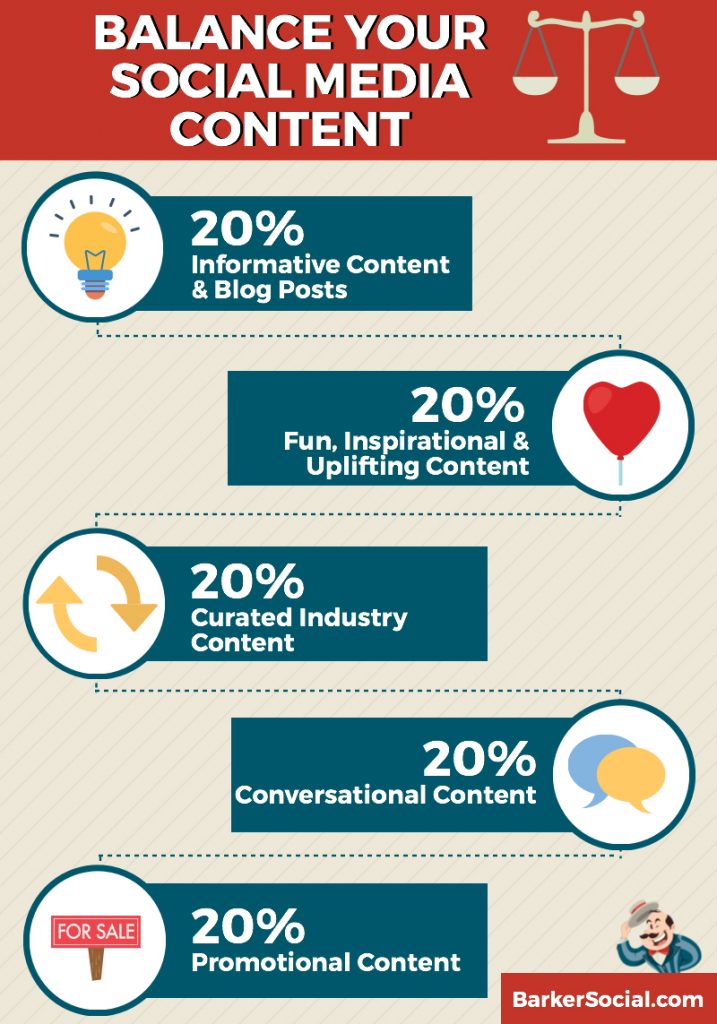
Content Marketing in Lindy Hop
Being well known and having a lot of followers isn’t enough. You need to stay in front of people within our global Lindy Hop community, and the best way to do that is with content marketing. Content marketing is about telling stories to get people interested in you, your brand, and your offering. It’s different from advertising, which is specifically trying to sell. Content marketing is giving away value for free in order to build trust.
People want to know and trust your brand before they buy from you. They desire storytelling that connects you with them on a very personal level. Lindy Hoppers want to know that you value them and that when they invest in your product, they’re investing in YOU in a way that will make a difference. When your potential customers feel a positive emotional and psychological connection with your brand, you can establish the trust that they’re craving that will allow them to spend their money with confidence.
These feelings are complex, especially because they’re not usually conscious.
When you give away value on an educational, entertaining, and personal level (like we talked about in part 1 with your offering) you’ll earn more brand familiarity and trust. Once you’ve built that trust, that’s when sales can be made.
On the one hand, you need to give away certain value for free as part of your content marketing. But not too much, since you’re also trying to make a living.
This is where social media, especially the time you give to managing your Facebook group and creating content for your Instagram and possibly TikTok, are a slippery slope. Because you can go down a serious rabbit hole where you’re creating loads of time-consuming content without seeing a monetary return on that investment.
Be Clear About How Your Free Content Is Driving Monetization
For a little while I was working with a yoga and nutrition lady to build her personal brand. She was pouring so much time and energy into creating content for social media in the form of videos and recipes. The problem was, it didn’t matter how many followers she had and how recognizable her name was in yoga and nutrition circles if she wasn’t making any money.
Essentially, she had seen some of the big yoga and nutrition people on social media with tens of thousands and followers and wanted to be like them. But she wasn’t clear about how she could make any money in the process.
The yoga lady had very few money-making offerings and they were not enough to justify the amount of time and effort, not to mention money, she was putting into her social media. I stopped working with her so she could move on to figure out how to create sustainable monetized solutions.
Digression: The Lindy Hop world has not really leveraged the influencer model very well, but I do see potential there at some point. If you can get big enough as an influencer on social media, you can get more than free stuff. Influential people within their niche can be paid to give reviews and talk about commodities on social media. But I don’t think we’re really there right now.
Your Efforts Must Generate Real Income
Is it a Hobby or a Business?
All this is to caution you against putting too much time into content that you aren’t monetizing into meaningful dollars. You need to use your talent, time, and content to support your monetized offerings. Gaining visibility and building your brand is important to build relationships and awareness for your brand and offering. Giving some things away for free can definitely help build goodwill in the community and towards your brand. And just selling all the time can sour how people perceive you. Some generosity with your content is beneficial, but there’s a line you need to keep an eye on.
Whether you’re making cool videos, sharing fun personal stories, writing blog posts, or creating free content in other ways, ultimately, you need to figure out how that’s leading to your financial sustainability.
When you share a blog post you wrote on Facebook that drives people to your website, you can softly remind people about your offer in your article. Or include it in your sidebar where they’ll see it while reading the free content. Follow up with your website visitors who have watched your free videos or read your free content by using the Facebook pixel to target them with ads for your paid offer.
Instagram is challenging because you only get one link—in your bio. You can set up a free LinkTree account to provide multiple link options to remind people about in your bio. One of the advantages of building your Instagram following is that when you reach more than 10K followers, you get access to the “swipe up” feature that lets you drive people to your url of choice.
Content marketing is great because it helps you to sell without being too salesy. It should always be a soft, gentle reinforcement of your offer. But that monetized offer needs to be firmly in place. The whole point of the free content is that it should be adding value and building your visibility to support your financial gain.
Flying Home
If you find yourself spending a lot of time making content or giving away your time in other ways and you’re not generating enough money, you need to get real with yourself. Are you creating amazing lessons that only a few people are buying? Are you hosting live events without any monetary return? Where’s the money?
Before you go any further with your endeavour, please check yourself. Is this a business or a hobby? Give yourself a bit of time to test out the desirability of your offer, your monetization, and full extent of the marketing capabilities that are available to you. But don’t spin your wheels for too long before seeing a return on your time and resource investments. You need to start making some serious money ASAP for this to work, and if it’s not working, it might be time for a different plan.
There are so many Lindy Hoppers struggling to create an online business right now. I know that your path is going to be hard. But our community and the world around us *is* changing. do believe there are new opportunities out there. I hope you’ll figure it out and make it work and I wish you every success.
